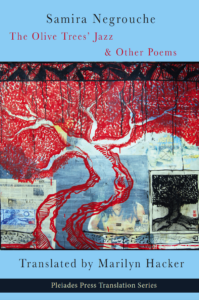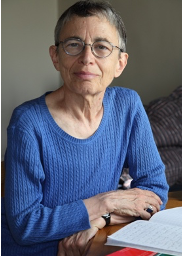 Samira Negrouche, author of The Olive Trees’ Jazz and Other Poems, and translator Marilyn Hacker discuss their collection with Pleiades Press intern Lauren Logan. In this stunning addition to the Pleiades Press Translation Series, published in February 2020, Samira Negrouche confronts a war-torn Algeria, amidst the Arab Spring, cataloguing, in her luminary genre-bending poetry, grief, exile, and revolution. Philip Metres writes of the collection, “A poetic descendant of Etel Adnan, Negrouche deftly moves from poems to prose, from coasts to caravans, from surrealist landscapes to erotic interiors. Writing in the empire’s language, Negrouche casts her poems into the “‘complex structure of silences’” that French can’t follow: “‘I would like / in a faraway language / to tell you what I don’t / understand.’” These are important poems, and Hacker gives us the gift of reading them in English for the first time in a collected volume.”
Samira Negrouche, author of The Olive Trees’ Jazz and Other Poems, and translator Marilyn Hacker discuss their collection with Pleiades Press intern Lauren Logan. In this stunning addition to the Pleiades Press Translation Series, published in February 2020, Samira Negrouche confronts a war-torn Algeria, amidst the Arab Spring, cataloguing, in her luminary genre-bending poetry, grief, exile, and revolution. Philip Metres writes of the collection, “A poetic descendant of Etel Adnan, Negrouche deftly moves from poems to prose, from coasts to caravans, from surrealist landscapes to erotic interiors. Writing in the empire’s language, Negrouche casts her poems into the “‘complex structure of silences’” that French can’t follow: “‘I would like / in a faraway language / to tell you what I don’t / understand.’” These are important poems, and Hacker gives us the gift of reading them in English for the first time in a collected volume.”
Lauren Logan: Marilyn, in your introduction to The Olive Tree’s Jazz, you mention that writing in French in Algeria is a form of protest against colonizers. Samira, do you see your poetry as a form of protest, and how do you both approach that sense of protest when translating the work into English?
Marilyn Hacker: I think I would say more specifically that an Algerian writer writing in French is laying claim to the language: it is her/his language as well, and as such is part of a trilingual, polyglot culture. A writer of Kateb Yacine’s or Mohammed Dib’s or Assia Djebar’s generation would have gone to school in French, and studied the French curriculum. One might make the comparison to the numerous Indian poets and novelists, living in India, who continue to write in English.
Samira Negrouche: If there is any protest in my work, it isn’t something I tend to show in the first layer. Being from a young independent country where history, language, memory and every other subject are vivid, intense and most of the time controversial, I try to resist the first emotion, the obvious way. If I protest it is through working toward the complexity of testimony, through avoiding to be kept in the infinite reaction.
Marilyn didn’t only translate the book, she has also recreated a path inside a sequence of nearly two decades of work, she knew exactly how to connect everything as a landscape to be also seen as two decades of Algerian history. With the huge protests that started in February 2019, I think the world discovered how important and violent this period has been for my country. It is no longer my life –it has never been–or not mine as a “protester” of any sort but as a translator of a certain complexity. Maybe to protest / to resist is to unveil, to translate.
LL: Marilyn, each language has its own idioms or turns of phrase that are difficult, if not impossible, to translate. How do you handle idiosyncrasies in French as you translate to English?
MH: Samira’s poems, while they’re not in an elevated or excessively “literary” diction, are not especially colloquial either–and it’s colloquialisms that might pose the problem of finding a more or less exact English equivalent, and choosing “which English?” They are poems in a “middle range” of language that is rich in description and allusion, and is colloquial only in that much, not all, of what is written in the poems could be said. Finding a level of language that was at once literary and “speakable,” remained a goal.
LL: Marilyn, is it difficult to maintain the emotional resonance of a poem in the translation process? How do you ensure that you translate feeling along with the literal meaning of words particularly the multitudes of linguistic meaning in Algerian French?
MH: While there is much that is specifically “Algerian,” in many of these poems, it’s more in terms of history/ landscape/cityscape/weather, described or referred to than a specifically “Algerian French” language – except in the occasional use of an Amazigh word or place name, which of course stays as it is, just as a Spanish word in a poem in English would stay Spanish. One of the pleasures of poetry translation for the poet/translator is just that mimesis to which you refer : the challenge of writing, or re-writing, in one’s own language, a poem whose history, narrative, point of view, linguistic challenges, are different than any poem one might write oneself – and writing it authentically, as a poem. That implies learning what you find in the poem that you don’t know: geography, history and their intersections. Not that it’s always literal history. The marvelous impressionist glimpsed narrative of the “Jasmine Monologues” wasn’t necessarily made clearer by my own experience of Cairo, Tripoli or Damascus…. I had to follow the language where it led, to re-imagine what was imagined.
LL: Samira, you rarely use punctuation in your poetry, and in some poems, like “Halt II,” you use no punctuation at all. Poems like “Halt II” also utilize enjambment. Could you discuss your approach to poetic style and form?
SN: These two poems have been written for The Indian Quarterly, they started from the memory of hiking in the Alps and from seeing a frozen lake at 23 00 meters. The poem mirrors the fluidity of a climbing breath as a metaphor to another ascension. When I suppress punctuation, it is most of the time to add some hesitation in the fluidity, as to remember the other layers / possibilities that can be seen or avoided. It is an ongoing laboratory that echoes the visual, the structure of music, and other structures but some other structures that could even be scientific or organic…The form I am looking for is a moving structure.
00 meters. The poem mirrors the fluidity of a climbing breath as a metaphor to another ascension. When I suppress punctuation, it is most of the time to add some hesitation in the fluidity, as to remember the other layers / possibilities that can be seen or avoided. It is an ongoing laboratory that echoes the visual, the structure of music, and other structures but some other structures that could even be scientific or organic…The form I am looking for is a moving structure.
LL: Samira, many of your poems are divided into subsections, as in “Zig-Zag Knots” and “To invent the word?” You use symbols to demarcate the divisions in the previous poems, but in poems like “The Olive Tree Jazz” and “Seven Little Jasmine Monologues,” you use written subheadings. How does creating sections within your work help you better communicate with your reader?
SN: I do use symbols in some sequences but those you are mentioning have been originally published in books of smaller sizes compared to the American format. Each fragment appearing in a single page like a slow projection of slides. Not a quick move of photographs on a smartphone…slides.
As the size of this book was different, the designer and the team of Pleiades Press suggested this possibility we were all happy with, both respecting the needed space and the fact that using this kind of symbols wasn’t strange in my work.
It says it is connected but yet it is a new slide.
In this book, the only section that originally had symbols is “Six makeshift trees around my bathtub” so it was important to use the same one everywhere in the book.
LL: Samira or Marilyn, the cover of the book features artwork by the recently deceased Yves Olry, a talented French artist. The cover art depicts a tree collaged with what looks like old photos and newspaper clippings: what significance does the cover of the book have to the contents of the poems? Do you see the cover art as political? How did you come across Olry’s work?
SN: I first met Yves Olry while he was engraving drawings on the façade of a new library close to Lyon, I was there for a book fair, he was ten meters over the ground. A year after, in 2004, I was invited in his town for four months as the poet in residence at Manoir de Grigny. I then discovered his work and we did many collaborations since then. When I published “Le Jazz des oliviers” in Algeria in 2010 I wanted one of his trees to be the cover, I love the intensity and the movement of his lines. Especially his trees. Also, every sequence in that book started with an art work by him, eight, all black.
For this edition, thanks to Sarah Nguyen who was curious to look at Yves’s work, she picked her favorite painting and asked Marilyn and me if we were happy with it. It is a mixed technique, a collage of newspapers covered by paintings.I checked every new work by Yves and couldn’t find a better choice for this book. It isn’t illustrative, it isn’t only because of “Le Jazz des oliviers” that represents only half of the book. I think we don’t have control in everything. I can just say that this cover is making more sense with time passing. I thought of it when I’ve seen images of trees burning in Australia for example.
Everything is political, you just need to choose the way you want to be political.
 Born in Algiers where she still lives, Samira Negrouche is a poet and translator, as well as a doctor who has privileged her literary craft over the practice of medicine. Prone to multidisciplinary projects, she has frequently collaborated with visual artists, choreographers, and musicians. She is the author of several books and artists’ books, mainly published in Algeria and France. Her poetry has been translated into over twenty languages, including Spanish, Italian, and Bulgarian. Her books include: : À l’ombre de Grenade (2003), Le Jazz des oliviers (2010) Six arbres de fortune autour de ma baignoire (2017) and Quai 2/1, partition à trois axes (2019).
Born in Algiers where she still lives, Samira Negrouche is a poet and translator, as well as a doctor who has privileged her literary craft over the practice of medicine. Prone to multidisciplinary projects, she has frequently collaborated with visual artists, choreographers, and musicians. She is the author of several books and artists’ books, mainly published in Algeria and France. Her poetry has been translated into over twenty languages, including Spanish, Italian, and Bulgarian. Her books include: : À l’ombre de Grenade (2003), Le Jazz des oliviers (2010) Six arbres de fortune autour de ma baignoire (2017) and Quai 2/1, partition à trois axes (2019).
Marilyn Hacker is the author of fourteen books of poems, including Blazons (Carcanet 2019), and A Stranger’s Mirror (Norton, 2015), and an essay collection, Unauthorized Voices ( Michigan, 2010). Other translations of French and Francophone poets include Vénus Khoury-Ghata’s A Handful of Blue Earth (Liverpool, 2017) and Emmanuel Moses’ Preludes and Fugues (Oberlin, 2016). She received the 2010 PEN Voelcker Award and the international Argana Prize for Poetry from the Beit as-Sh’ir/ House of Poetry in Morocco in 2011. She lives in Paris.
